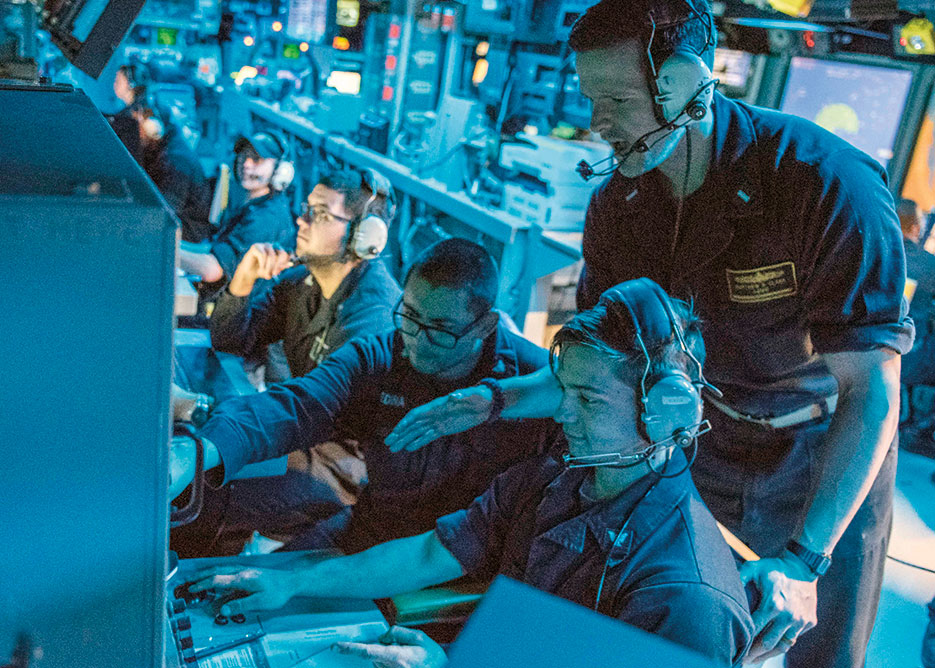Bradley DeWees, Terry C. Pierce, Ervin J. Rokke, and Anthony Tingle
Toward a Unified Metric of Kinetic and Nonkinetic Actions: Meaning Fields and the Arc of Effects
23 èþëÿ 2017
April 1, 2017 — There is a critical need for new thinking on how the United States can better meet the full spectrum of kinetic and nonkinetic 21st-century security challenges. Revolutionary changes in information technologies, communications, and the composition of both nation-state and nonstate actors necessitate a change in our approach toward national security. Though emerging cyber capabilities tend to dominate current defense dialogues, technological advances in the traditional domains of land, sea, air, and space also demand a concept for holistically assessing the reality of our national security environment and the effects of actions we take toward those ends. In short, we need a unified cognitive approach for assessing and measuring kinetic and nonkinetic actions.
Recent work has suggested an incremental movement from our traditional focus on combined arms warfare toward combined effects power and has explicitly called for the crafting of desired effects by appropriate civil-military authorities at the tactical, operational, and strategic levels.1 This incremental shift in focus from traditional instruments of warfare toward desired effects opens the door for a more holistic consideration of the broad spectrum of security instruments, both kinetic and nonkinetic and across all domains. The challenge we face now is how best to assess and measure effects, particularly those of a subjective character such as the adversaries’ morale, courage, willingness to fight, and views of their security environment.
In this article, we introduce two constructs: the arc of effects, which describes the continuum of national security actions, and meaning fields, which describe how our actions create different adversarial effects. Concurrently, we further develop the definition of effects. We believe that these concepts are the initial stages to developing a cognitive path for achieving holistic, unified measurements of kinetic and nonkinetic effects in all domains, including the increasingly important cyber domain.

USS Toledo, assigned to Commander, Task Force 54, transits through Arabian Gulf, January 21, 2016 (U.S. Navy/Torrey W. Lee)
The Arc of Effects
Traditionally, our military has tended to measure effects in the natural domains (land, sea, air, and space) in terms of physical outcomes, with the focus on linear measurement of destruction caused by kinetic instruments of power. An emphasis on the physical domains has led us to neglect an important characteristic of warfare. Actions during conflict exist on a continuum, ranging from the purely physical to what Carl von Clausewitz termed “moral forces.” These moral forces encompass more ephemeral factors such as motivation, will, spirit of sacrifice, patriotism, and courage.2 We present a construct—the arc of effects—for better understanding and referencing physical and moral effects.
While the physical results of kinetic operations are relatively well understood and can be measured with some precision (even when considering second- and third-order effects),3 effects toward the moral end of the arc are more difficult to measure because they require a degree of “military empathy,” or the ability to consider the enemy’s perspective. The challenge of considering the enemy’s perspective becomes exponentially more difficult when the existing environment is altered, for example, through the introduction of a new domain such as cyber, with substantial nonkinetic as well as kinetic potential.
Dissonance, such as that forced by a new domain, is common throughout military history. Just prior to the outbreak of World War I, Sir Arthur Conan Doyle wrote a fictional account of the defeat of Great Britain by unrestricted submarine warfare. At the time, it was farfetched to believe that Germany would use submarines to sink merchant vessels and to logistically isolate Britain. Because Doyle’s ideas did not conform to the naval zeitgeist, they were summarily dismissed by the military establishment. Submarines were a radical and complex technology designed to function in a new domain of warfare, and surface navies were slow to understand the domain below the sea, ignoring its potential impact. Almost immediately at the onset of submarine warfare, countries became aware of the physical results (the loss of shipping) but were less timely in appreciating its potential effects on the moral forces end of the spectrum (uncertainty and terror).4
The submarine example is analogous to the rising contemporary challenge of nonkinetic effects. We are both reluctant and unable to define or fully understand the extent of these effects because we have traditionally emphasized the physical end of the arc of effects. This deficiency also limits our government’s capacity for devising an effective deterrent to the full range of security threats and allows our opponents greater freedom of maneuver. In short, we need a tool for navigating the arc of effects that enables us to identify and assess the full spectrum of physical and moral forces.

Sailor assigned to USS Mahan talks to sonar technicians about attack options during anti-submarine warfare training in Arabian Sea, January 17, 2017 (U.S. Navy/Tim Comerford)
Meaning Fields
Clausewitz insisted that to be victorious, we must convince our enemies that they are defeated.5Victory requires that our adversaries perceive the totality of our actions that create an unacceptable environment. This perception, or “meaning,” that emerges on the part of the adversary is what we define as an “effect.” When assessing or measuring such effects, a major challenge exists with the more subjective, moral side of the arc of effects. Unlike the physical effects of kinetic actions, which we can usually measure with some precision, moral effects are defined by the adversary and are thus more difficult to assess.
To meet this challenge, we offer a metaphor from the discipline of quantum physics, which we call meaning fields. The idea of “fields” is an elementary component of quantum physics. While early Newtonian physics focused on a body and the forces acting upon it, quantum physics explains the physical world as the result of particles moving through and being connected by fields (for example, electromagnetic fields or gravity), much like a blanket connecting individual patches of cloth. One ubiquitous field, the Higgs Field, is of particular significance because it imparts mass onto particles as they pass through it. The more substantial the particle, the more mass the Higgs Field imparts upon it. Because it imparts mass, the Higgs Field allows particles to join together, forming the foundation on which the rest of the universe is built.
We liken the Higgs Field to meaning fields, which we assert surround all actors in the international security arena, be they individuals, organizations, subnational groups, or nation-states.6 A major difference, however, between our metaphorical fields and the Higgs Field is that there are many meaning fields, with every actor—from individuals to nation-states—possessing its own. Such meaning fields are a representation of how actors bestow meaning on actions of the external world and are constructed, inter alia, of human nature, culture, education, historical experiences, and circumstance. In the same way that the Higgs Field imparts mass to an object moving through it, meaning fields impart meaning on security-related actions or lack thereof.7 Actions that do not intersect our adversaries’ meaning fields (that is, that go unnoticed by the target actor) are imparted no meaning and are irrelevant. In short, the result of interaction with a meaning field is what we define as an effect.
We believe that the meaning field concept can provide a cognitive pathway to better understand the full spectrum of the arc of effects and is useful for military planners to assess how opponents impart meaning to external actions. The meaning field construct attracts the right kind of questions, including thoughts on which meaning fields are most relevant. Unlike measures of effects that focus primarily on attrition and destruction, the meaning field concept is more likely to accommodate effects on the moral side of the arc because it more explicitly addresses the Clausewitzian emphasis on how the enemy understands our actions. A second advantage of the meaning field construct is that it offers a means for assessing the effect of inaction. It draws attention to how actors other than ourselves see the world, including the proposition that inaction can have just as much of an effect as action. Third, the construct provides a pathway for measuring follow-on (second-, third-, fourth-order) effects.8
Despite these advantages, the meaning field concept is also a humbling tool. It complicates the security picture by exponentially increasing the number of variables military policymakers must consider. It also makes apparent the uncomfortable reality that when we take actions to achieve desired effects, our own meaning fields are often irrelevant to our opponents.9 Thus, to be effective managers of effects, our focus must be on our opponent’s meaning fields. Without understanding an adversary’s meaning field, the default instinct is to focus on the less complicated metrics associated with the physical side of the arc of effects. While these kinetic effects can be measured with relative precision and circumvent the challenge of additional analysis, it is perilous for countries to neglect their adversaries’ meaning fields.

Sailor assigned to Blue crew of ballistic missile submarine USS Maine receives her submarine warfare officer device at Naval Base Kitsap-Bangor, Washington, December 5, 2012 (U.S. Navy/Ahron Arendes)
Tactical- and Operational-Level Model Application: The Fall of Singapore
One of the most devastating defeats in the history of the British military had its roots in the moral region of the arc of effects. On December 7, 1941, as the Japanese surprised the Americans at Pearl Harbor, they simultaneously attacked the British Empire on the islands of Singapore, leading to what would become a painful embarrassment and costly strategic setback for the British.10 Although outnumbered almost three-to-one, the Japanese were victorious against what was widely considered a vastly superior force in large measure because of their superior ability to assess and understand the meaning field of their British opponent.
The defenses on the main island of Singapore were considered a crowning achievement of the British Empire in the Far East. At the time, the fortress contained the largest fixed-position cannon in the world. These guns, like most of the defenses on the island, were initially positioned to defend from a southerly sea attack. The British discounted a Japanese attack from the Malaysian Peninsula, as any amphibious landing within proximity of the main island would be slowed by the dense jungle and could be interdicted by overwhelming land forces. The British meaning field assumed that strength was measured in the metric of total forces, especially heavy forces, and that those forces were most effective in open terrain.
The Japanese upended the British meaning field. Led by General Tomouki Yamashita, the Japanese amphibious assault occurred near the northern border of Malaya, well outside the influence of British forces.11 Aware of the advantages of blitzkrieg tactics, Yamashita focused on speed of maneuver. His relatively light forces blazed through the jungle, using bicycles, fixing partially destroyed bridges at night, and viciously giving no quarter, as prisoners slowed their advance. With the preponderance of the British air component being destroyed early in the assault, the Japanese were able to press across the peninsula relatively unimpeded, overrunning the British, taking valuable airfields, and reinforcing a cycle of rapid Japanese success.
The final Japanese victory over the main island of Singapore was as remarkable as their initial 600-mile march to capture Malaya in just 54 days. With a recklessly low ratio of attackers to defenders, and with supplies and morale running low on both sides, Yamashita pressed the assault. In a last-ditch effort to force British capitulation, Yamashita ordered a massive artillery shelling of the city (expending the last of his stores) to feign unlimited resources. Additionally, with a view toward the moral forces end of the arc of effects, Yamashita attacked the city’s water supplies instead of the British-defended city proper. With dead bodies accumulating in the streets and facing the prospect of dying of thirst, the British surrendered.
Superior Japanese understanding of the British meaning field, as well as audacity and determination, led to the fall of Singapore. The Japanese asked not how to defeat the British forces, but how to sap the British will to fight. We argue that modeling meaning fields in the planning process could prompt our forces to ask the same questions. For the British, their failure could have been prevented by constructing a meaning field of the Japanese view of Malaya, a view that focused on more than the physical side of the arc of effects.
Strategic-Level Model Application: Russia’s Gray-Zone Warfare
While the example of Singapore represents a tactical and operational application of the meaning field construct, the model is also valuable in analyzing both kinetic and nonkinetic strategic-level effects. Russia’s actions in Ukraine represent what is often referred to as “gray-zone” warfare, or the aggressive application of asymmetric and conventional techniques (including diplomatic, informational, military, economic, and other political forces) designed to achieve political goals while maintaining hostilities below the threshold of conventional war. In this section, we examine the problem of Russia’s gray-zone warfare in the context of both the arc of effects and meaning fields.
Russia’s actions against Ukraine, often referred to as hybrid or new-generation warfare, encompass both the physical and moral components of the arc of effects. The physical forces component of Russia’s strategy includes conventional strikes, train and equip operations, and Spetsnaz incursions, while nonkinetic elements include information warfare with distributed and focused cyberattacks.12When considering hybrid warfare strategies, we are forced to consider the entire arc of effects and the resulting synergies of simultaneously employing kinetic and nonkinetic means.
The underpinning concepts behind hybrid warfare are not new. At its core, hybrid warfare is simply a combination of asymmetric and regular warfare—the existence of which has been present throughout history.13 So what is the basis for our current fervor over the dangers of hybrid warfare and gray-zone conflict? Clearly the Russia-Ukraine conflict brings a change in the technological character of war. A lack of understanding nonkinetics and cyber operations prevents our senior policymakers from articulating actionable desired effects and deterring gray-zone type incursions.
Successful gray-zone operations rely heavily on ambiguity and the adversary’s resulting inaction. In the absence of strict international policies and laws regarding hybrid warfare actions, aggressors operate with relative impunity.14 While Ukraine is not a member of the North Atlantic Treaty Organization (NATO) and is not privy to protections under Article 5, Russia’s invasion clearly violates international norms against annexation. Decisionmakers in gray-zone situations are often unable to articulate and uphold diplomatic “red lines.” To counteract gray-zone warfare, the need to understand the adversaries’ meaning fields becomes paramount.
So it is that the meaning field construct provides a cognitive path for dealing with security problems such as hybrid warfare. Throughout this article we have portrayed our adversary’s meaning field as at least as important as our own. Regarding Russia, it appears that Vladimir Putin’s meaning field was not considered adequately when deciding to expand NATO. And now the West’s inaction toward Russia’s aggression into Ukraine is presenting itself as a particle through Putin’s meaning field. By understanding our behavior in terms of meaning fields, we are better able to articulate our desired effects and produce viable counters to hybrid warfare actions.
In sum, the meaning field construct can focus our efforts to counter gray-zone conflicts. While the U.S. Government has the means to oppose these types of hybrid threats, economy of force and the threat of escalation are underlying concerns. Possible solutions to hybrid warfare include train and equip (proxy) operations, special operations forces, massive nonkinetic retaliation, and conventional strikes. Any combination of these options, including our own hybrid warfare, is a possibility.15 By predicting our adversary’s response to our actions using the meaning field theory, it is possible to achieve our desired effects through the most economical and politically palatable means available.

Sea Hunter is part of DARPA’s Anti-Submarine Warfare Continuous Trail Unmanned Vessel program, in conjunction with ONR (U.S. Navy/John F. Williams)
Conclusion
The British strategy for the defense of Singapore reflected their own meaning field, which the Japanese correctly perceived was predicated on a traditional force-on-force strategy. However, this is not how the Japanese perceived the operational environment. They viewed the terrain, defenses, and the entire island system in terms of how it would affect the British will to fight. Similarly, the United States and our allies are slow to consider our actions in regard to Russia’s meaning field.
We need to apply the meaning field concept across all domains. The growth of cyber is just one example of a technological advance that spans the physical and moral side of the arc of effects. The risk we run with this technological advance is forcing it into the physical side of the arc of effects. We make this mistake because it is convenient to think in terms of physical forces rather than in terms of how the enemy sees the world.
The meaning field concept provides a cognitive path for moving our focus toward the mind of possible adversaries in the interconnected world of national security. The notion that military leaders should focus on the mind of the enemy is not new; it was the basis of Sun Tzu’s Art of War. But more than two millennia after Sun Tzu, we still lack a means to effectively incorporate his advice directly to measuring effects. We continue to define effects based largely on our own intuition rather than in terms of how the enemy sees the world. We see the meaning fields concept as a helpful point of reference in the doctrinal process for reorienting military leaders to the mind of the enemy.
If we seek to defeat our adversaries, we must first perceive their meaning fields. Doing so would increase the probability that we will think like the enemy (minimizing the “mirror imaging” problem) and a greater probability of achieving desired effects. Moreover, this concept allows us to consider multiple, increasingly complex and interconnected adversaries who strive to operate beyond the second and third orders of effects. By understanding meaning fields, we access the entire span of the arc of effects, creating a definition of “effects” that unites all possible domains of warfare. JFQ
Notes
1 See Ervin J. Rokke, Thomas A. Drohan, and Terry C. Pierce, “Combined Effects Power,” Joint Force Quarterly 73 (2nd Quarter 2014); and James G. Stavridis, Ervin J. Rokke, and Terry C. Pierce, “Crafting and Managing Effects: The Evolution of the Profession of Arms,” Joint Force Quarterly 81 (2nd Quarter 2016).
2 Carl von Clausewitz, On War, ed. and trans. Michael Howard and Peter Paret (Princeton: Princeton University Press, 1989), 97.
3 When focusing only on physical results, the follow-on effects are relatively simpler to discern than nonkinetic (moral forces) results.
4 According to Michael L. Hadley in Count Not the Dead: The Popular Image of the German Submarine (Montreal: McGill-Queen’s University Press, 1995), 14: “The submarines had done so by isolating the vital centre of the British Empire through direct attacks that entirely evaded the might of the British surface fleet.”
5 Clausewitz.
6 The authors credit Lieutenant Colonel Mario Serna, USAF, for his assistance in translating the Higgs Field metaphor into the meaning field. Also see Sean Carroll, California Institute of Technology, “The Higgs Boson and Beyond,” The Great Courses, 2015.
7 Meaning fields can also impart meaning upon inaction. For inaction to be considered significant vis-à-vis meaning fields, we must consider two factors: expectation of action and time. An adversary must expect some action (which is never taken), and the appropriate amount of time must pass. An example of significant inaction in this context is the relative U.S. inaction in the face of Syria’s use of chemical weapons in 2013, and the meaning that the Bashar al-Asad regime imparted to this inaction.
8 For every action, there are consequent actions and effects. Each initial action passes through all meaning fields, producing effects. Each one of these effects then passes through all meaning fields, producing another effect (a second-order effect). This cycle is repeated, with each order effect being influenced by the relevant meaning fields. If the military planner is cognizant that all actors have unique meaning fields, then once the initial meaning field is considered, it becomes easier to accurately comprehend and possibly predict second-, third-, fourth-, and fifth-order effects. This visualization is the first step in understanding ordered effects of our actions.
9 When considering the desired effects of our actions, the opponent’s perception of our meaning field is often irrelevant. Simply put, our adversaries are often equally negligent when considering meaning fields.
10 Due to the International Date Line disparity, this was the date of the event in the United States. The actual date in Singapore was December 8, 1941. The Japanese initially attacked the islands by air.
11 These forces constituted a coalition from across the British Empire, including British, Australian, and Indian troops.
12 Patrick Duggan, “Strategic Development of Special Warfare in Cyberspace,” Joint Force Quarterly79 (4th Quarter 2015).
13 For a historical perspective on the existence of hybrid wars, see Frank G. Hoffman, “Hybrid Warfare and Challenges,” Joint Force Quarterly 52 (1st Quarter 2009).
14 See U.S. Special Operations Command, “The Gray Zone,” September 9, 2015.
15 Joseph Votel et al. suggest that the most effective counter to hybrid warfare is hybrid warfare. See Joseph Votel et al., “Unconventional Warfare in the Gray Zone,” Joint Force Quarterly 80 (1st Quarter 2016).
Âåðíóòüñÿ íàçàä